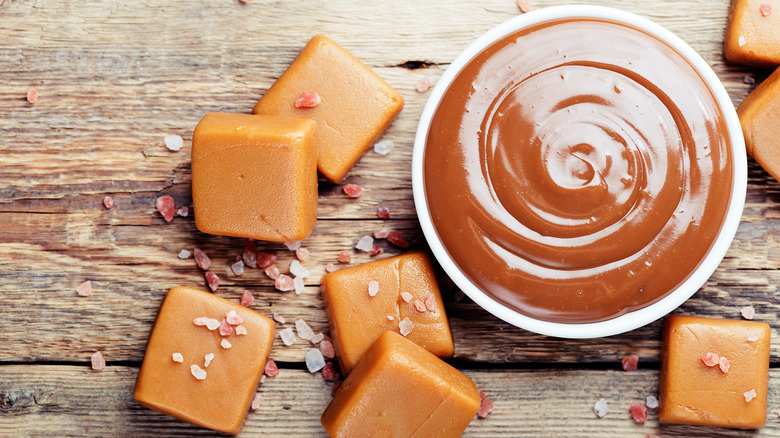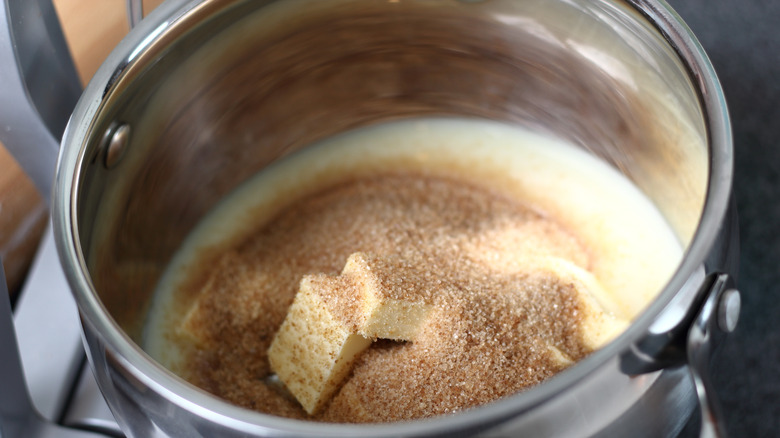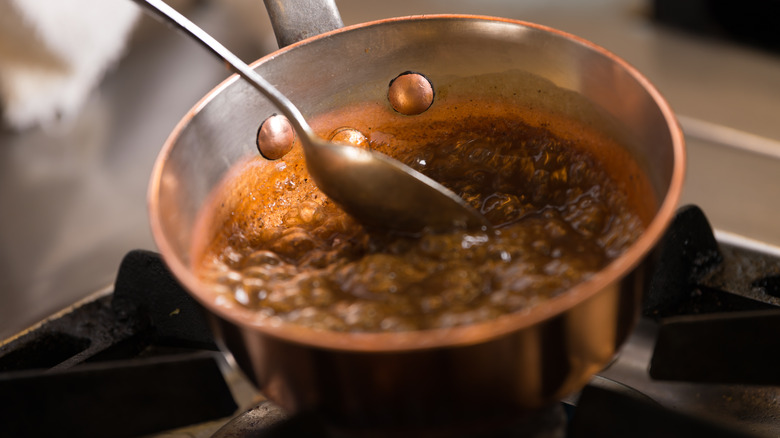Toffee And Caramel Are Not The Same Thing
First, let's get the big commonalities out of the way — caramel and toffee are delicious results of cooking sugar until it turns a deep honey brown. Both also (generally) use some form of dairy to add flavor and moisture and give the sugar something to melt into. And if you came across pieces of either in a bowl, you'd reach for a couple. However, just like the same egg can be turned into fluffy scrambled eggs or a delicate omelet, sugar can be turned into either of these two different treats, depending on how it's cooked.
As to the dividing line — toffee is cooked at higher temperatures to give it the characteristic crunchy or hard chewy texture. Caramel, on the other hand, is allowed to retain more of its moisture and can be kept at the consistency of a viscous sauce or thickened into a softer, chewy candy.
The ingredients used to make toffee and caramel also differ slightly. The former can be made using sugar and butter, while caramel combines sugar and heavy cream. When cooked, the additional dairy in caramelgives it a deeper, nuttier flavor and moisture for a softer texture. With just a few changes and a careful eye on the heat, you can make toffee, caramel, or even butterscotch (candy, not syprup), which falls somewhere in between the two.
Toffee and caramel have different (but overlapping) ingredients
The simple sugar-butter-water recipe gives toffee its characteristic sweet and buttery notes. While regular white sugar can be used, toffee is often made with brown sugar to give it a more rounded flavor. Homemade brown sugar is also surprisingly easy to make and results in a rich yet mellow-flavored toffee that's a good base for roasted nuts, dry fruits or any other embellishments you feel like trying out. Since there is such little moisture in the final product, the toffee will always have a firm texture, and hard toffee can turn into crunchy shards that work great as a topping. This is not to be confused with the crunchy caramel that tops a crème brûlée or caramel custard, which is basically sugar and a touch of water and is sometimes called dry caramel.
Wet caramel, the kind made into sauces and candy, is creamier than toffee since its recipe also calls for heavy cream, which is added once all the sugar has melted. Corn syrup is also added to stop sugar crystals from forming, keeping the texture smooth (unlike the toffee shards mentioned above). The richer taste of caramel also benefits from some added vanilla essence, while both caramel and toffee sometimes get a pinch of salt to balance the sweetness and bring out more flavor.
Toffee vs caramel: textures and temperatures
When cooking the ingredients, toffee is made by heating sugar to over 300 degrees Fahrenheit until it reaches a crunchy consistency called the hard-crack stage. When heated only to about 270 degrees Fahrenheit, the toffee is still in the chewy soft-crack stage, making it butterscotch. Therefore, toffee is essentially butterscotch cooked longer and to a higher temperature until it becomes more brittle.
Caramel also starts with melted sugar, but once heavy cream is added, it is heated only till about 230 degrees Fahrenheit. This helps retain moisture while cooking the cream to give the caramel a depth of flavor. Caramel may be cooked for longer or shorter durations depending on the consistency required. It is initially a sauce that can be used as a topping; when cooked further, it becomes the shiny coating you see on caramel apples. More time on the heat turns it into chewy caramel candy that can be covered in chocolate or eaten as is.
Thus, toffee and caramel are decidedly different confections, but the line between them often blurs. For example, heavy cream can sometimes be added to the toffee mixture to make it softer and richer. The best way to distinguish between the two is by the temperatures at which the sugar is caramelized.


